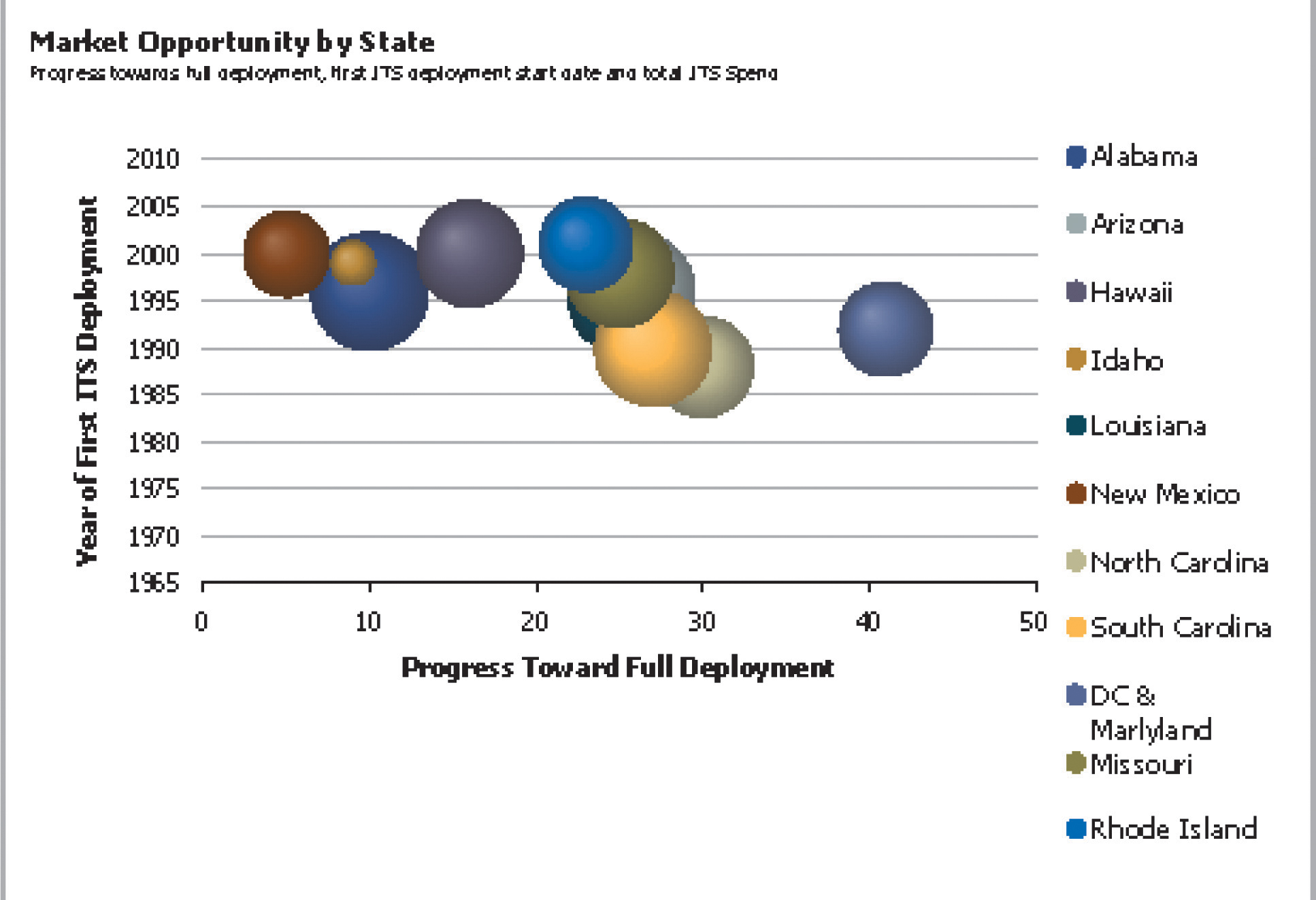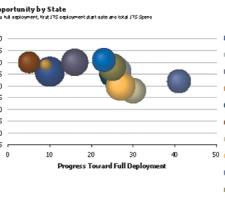
Paul Everett, Research Director with IMS Research, looks at how ITS deployment varies across the US and what this means in terms of market potential for systems manufacturers and suppliers
At the end of 2010, the US will have a total resident population of close to 310 million, rising to an estimated 439 million by 2050. With roughly 80 per cent of the population residing in cities and suburbs, and each home typically owning between one and two cars, it is clear that the nation's roads are likely to become increasingly congested in the coming years. This should be music to the ears to suppliers of Intelligent Transport Systems (ITS). However, the sharp reality is that government procrastination and a reduction in funding has slowed the progress of ITS on a national level and has created a market comprised in the main of sporadic projects at a state level. As a result, a large number of states are tending to go in their own direction and are not realising the true synergies that can be achieved with ITS.Despite the aforementioned market outlook, it's certainly not all doom and gloom for ITS suppliers in the US. While the market is certainly fragmented, a lot of work is going on behind the scenes in educating the market, opening the eyes of individuals to the benefits that ITS can bring. From a project standpoint, there is a discernable trend towards larger projects, as can be seen from the following four examples:
•Developed at a total cost of $140 million, the Georgia Navigator is an Advanced Transportation Management System (ATMS) that monitors and manages traffic conditions on 90 miles of interstate highway in the Atlanta Metropolitan area.
• By 2013, ITS deployments in Kansas City and St. Louis will be in the region of $75-80 million and $110 million respectively.
•The state of Massachusetts has a large ITS project planned to be funded through the 2010 Transportation Improvement Program for the
•New Jersey plans to expand the instrumentation of its interstates and freeways by installing video surveillance cameras at every interchange, with one camera at least every two miles in urban areas and every five miles in rural areas. Video surveillance cameras will also be installed at all major bridges for both traffic and security coverage, with DMS on each approach for interchanges with Interstates/freeways, state highways and other selected roads. The state also plans to roll out travel time detectors at every sign location and at other decision points. This will involve an estimated spend of $400 million over 10 years for the period from 2007 to 2016.
About IMS Research
IMS Research is a supplier of market research and consultancy services on a wide range of global electronics markets. The company is supported by headquarters in Wellingborough, UK and offices in Austin, Texas, Seoul, Korea, Taipei, Taiwan and Shanghai, China. It offers an extensive portfolio of transport-related market research. Working closely with equipment suppliers, regional and local governments and associations, IMS Research collects primary data to track the extent to which intelligent transport systems are being used around the world. In addition to its core ITS research, IMS Research is also able to offer research in other related technology markets including ANPR and detection sensor technologies.
State and city comparison
While penetration of ITS for the US as a whole is low compared to other developed countries, a closer look at a state and city level reveals a completely different picture, and further illustrates the opportunities that the US market presents to ITS suppliers. For example, the state of California has the largest ITS spend but still has only 6.6 per cent of its roads covered by video surveillance, and hence there may still be opportunity for further development within the state. This is also true with Road Weather Information System (RWIS) and DMS deployment with neither having greater than 20 per cent penetration. Should ITS make a larger play within rural applications, the market opportunity could be even larger.Some 60 per cent of states in the US are projected to spend between $10-$50 million on ITS during 2010. These states are either in the process of finishing their initial ITS deployments or are actively working with ITS to improve road conditions. Not only are project spends increasing but at the same time early adopters of ITS are beginning to look at more sophisticated systems, taking what technology they have and challenging it to provide more. For example, New York City has taken its tolling system and enhanced it to provide incident detection and also to help with traffic planning. This was not the original design concept when installing ITS for tolling.
In Illinois, IDOT, the state department of transportation, has been an early adopter of ITS equipment to enhance traffic management, improve traveller information, and improve the safety and efficiency of the state's highway network. IDOT has also been a national and international leader in the development and deployment of ITS. For it, ITS development started back in the 1960s when the IDOT Traffic Systems Center (TSC) established one of the first real-time expressway surveillance and management systems in the world. Since this initial deployment, the Department has recognised the need for technological advancements to increase the safety and efficiency of the state's surface transportation system and to provide a valuable mechanism to improve information flow to the public.
As technology continues to progress, other states are likely to gradually increase their spends on ITS, with systems increasing in size and each state becoming more aware of the benefits that ITS can bring. As a result, states such as Kentucky, Oklahoma and Tennessee hold more long-term opportunities, while the opportunities in states such as Alabama, Arizona and North Carolina are more immediate (Figure 1).
Technology focus areas
ITS can encompass a broad range of electronic components, communications and information processing technologies. At this point in time, in terms of technology there is a distinct focus on ATMS, which for most states in the US account for more than 75 per cent of funds allocated to be spent on ITS in 2010. In its latest report, 'US Market for Intelligent Transport Systems', IMS Research looked in detail at the core devices that make up ATMS, namely video surveillance cameras, DMS, RWIS and road sensors.Across the US the penetration of video surveillance is quite evenly distributed across states in the north-east, south and west. Video surveillance penetration in the mid-west was not found to be as high as in the rest of the country. Largest penetration, of 4.9 per cent and 2,740 video surveillance cameras, was found in the north-east. States in the north-east are typically smaller than those in the south and mid-west and this goes some way to explain why penetration is not as strong in the latter regions. In terms of total numbers of cameras deployed, the southern US has by far the most deployments, with 4,678 video surveillance cameras. It is followed by the west coast with 3,958.
While the use of road traffic sensors is widespread across the US, deployments in certain states are larger than in others. The southern US was found to have the most sensors deployed, and the highest penetration rate of 25.0 per cent. This is not surprising since five of the 10 largest sensor deployments can be found in southern states. As with video surveillance, the mid-west has the smallest number of sensors deployed and the lowest penetration in the US.
DMS deployments were also found to be widespread, with the north-east, western and southern states all having a similar level of DMS deployed. The north-eastern states are currently the most highly penetrated (9.6 per cent) while the largest number of deployments can be found in southern US states.
Unlike video surveillance, road sensors and DMS, the market for RWIS has significant regional variation, with the vast majority of deployments and hence market penetration being found in western US states (which account for nearly half of all RWIS deployed in the US). IMS Research has estimated that there were a total of 2,745 RWIS used in the US. This suggests a market penetration of 9.5 per cent (Figure 2).
The deployment of ITS across the US will take years, if not decades to complete. The fundamental requirements for future growth opportunities will certainly depend on the level of funding, the ability of regional DOTs to demonstrate the success of working ITS projects to the public, increased training opportunities for ITS professionals, and education. Only by working together will each of the US's states realise the true synergies that can be achieved.












